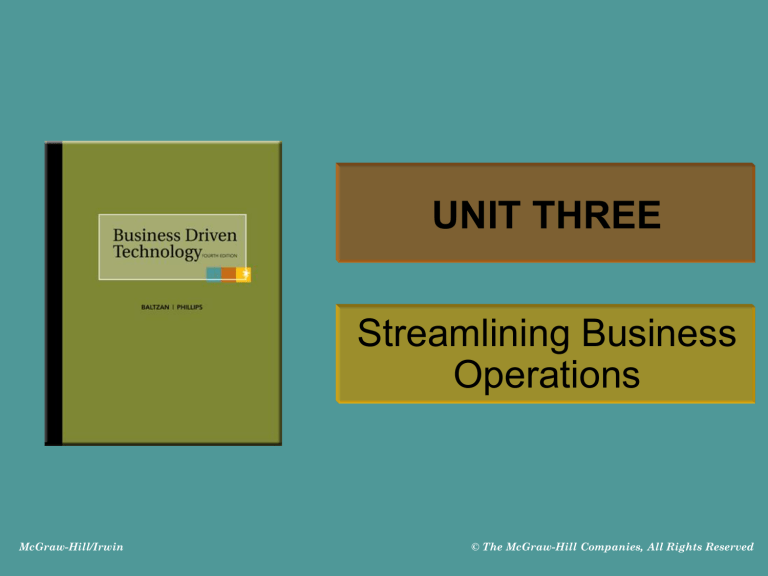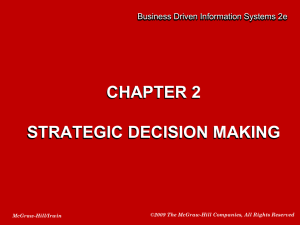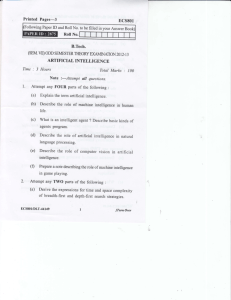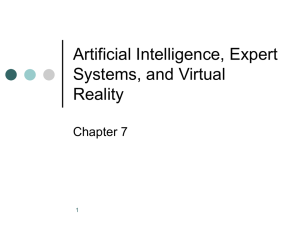
UNIT THREE
Streamlining Business
Operations
McGraw-Hill/Irwin
© The McGraw-Hill Companies, All Rights Reserved
UNIT THREE
• Chapter Nine – Enabling the Organization—
Decision Making
• Chapter Ten – Extending the Organization—
Supply Chain Management
• Chapter Eleven – Building a Customer-centric
Organization—Customer Relationship
Management
• Chapter Twelve – Integrating the Organization
from End to End—Enterprise Resource Planning
9-2
UNIT THREE
• Decision-enabling, problem-solving, and
opportunity-seizing systems
9-3
CHAPTER 9
Enabling the
Organization—Decision
Making
McGraw-Hill/Irwin
© The McGraw-Hill Companies, All Rights Reserved
LEARNING OUTCOMES
9.1 Define the systems organizations use to
make decisions and gain competitive
advantages
9.2 Describe the three quantitative models
typically used by decision support systems
9-5
LEARNING OUTCOMES
9.3 Describe the relationship between
digital dashboards and executive
information systems
9.4 List and describe four types of artificial
intelligence systems
9-6
DECISION MAKING
9-7
DECISION MAKING
• Model – a simplified representation or
abstraction of reality
• IT systems in an enterprise
9-8
TRANSACTION PROCESSING
SYSTEMS
• Moving up through the organizational pyramid users move
from requiring transactional information to analytical
information
9-9
TRANSACTION PROCESSING
SYSTEMS
•
Transaction processing system - the basic business
system that serves the operational level (analysts) in an
organization
•
Online transaction processing (OLTP) – the capturing of
transaction and event information using technology to (1)
process the information according to defined business
rules, (2) store the information, (3) update existing
information to reflect the new information
•
Online analytical processing (OLAP) – the manipulation
of information to create business intelligence in support of
strategic decision making
9-10
DECISION SUPPORT SYSTEMS
•
Decision support system (DSS) – models information to
support managers and business professionals during the
decision-making process
•
Three quantitative models used by DSSs include:
1. Sensitivity analysis – the study of the impact that
changes in one (or more) parts of the model have on
other parts of the model
2. What-if analysis – checks the impact of a change in an
assumption on the proposed solution
3. Goal-seeking analysis – finds the inputs necessary to
achieve a goal such as a desired level of output
9-11
DECISION SUPPORT SYSTEMS
• What-if analysis
9-12
DECISION SUPPORT SYSTEMS
• Goal-seeking analysis
9-13
DECISION SUPPORT SYSTEMS
• Interaction between a TPS and a DSS
9-14
EXECUTIVE INFORMATION
SYSTEMS
•
Executive information system (EIS) – a
specialized DSS that supports senior level
executives within the organization
•
Most EISs offering the following capabilities:
– Consolidation – involves the aggregation of
information and features simple roll-ups to complex
groupings of interrelated information
– Drill-down – enables users to get details, and
details of details, of information
– Slice-and-dice – looks at information from different
perspectives
9-15
EXECUTIVE INFORMATION
SYSTEMS
• Interaction between a TPS and an EIS
9-16
EXECUTIVE INFORMATION
SYSTEMS
• Digital dashboard – integrates information
from multiple components and presents it in
a unified display
9-17
ARTIFICIAL INTELLIGENCE (AI)
• Intelligent system – various commercial
applications of artificial intelligence
• Artificial intelligence (AI) – simulates
human intelligence such as the ability to
reason and learn
9-18
ARTIFICIAL INTELLIGENCE (AI)
• The ultimate goal of AI is the ability to build a
system that can mimic human intelligence
9-19
ARTIFICIAL INTELLIGENCE (AI)
•
Four most common categories of AI include:
1. Expert system – computerized advisory
programs that imitate the reasoning processes
of experts in solving difficult problems
2. Neural Network – attempts to emulate the way
the human brain works
– Fuzzy logic – a mathematical method of handling
imprecise or subjective information
9-20
ARTIFICIAL INTELLIGENCE (AI)
•
Four most common categories of AI include:
3. Genetic algorithm – an artificial intelligent
system that mimics the evolutionary, survival-ofthe-fittest process to generate increasingly
better solutions to a problem
4. Intelligent agent – special-purposed
knowledge-based information system that
accomplishes specific tasks on behalf of its
users
9-21
DATA MINING
•
Data-mining software includes many forms of
AI such as neural networks and expert
systems
9-22
OPENING CASE STUDY QUESTIONS
SecondLife
1. How could companies use Second Life to
enhance decision making for a new product or
service?
2. How could financial companies use neural
networks in Second Life to help their
businesses?
9-23
OPENING CASE STUDY QUESTIONS
SecondLife
3. How could a company such as Nike use
decision support systems on Second Life to
help its business?
4. How could an apparel company use Second
Life to build a digital dashboard to monitor
virtual operations?
9-24
CHAPTER NINE CASE
DARPA Grand Challenge
•
The DARPA Grand Challenge was designed
to leverage American ingenuity to develop
autonomous vehicle technologies that can be
used by the military
•
With the goal of saving lives on the battlefield,
the DARPA Grand Challenge brings together
individuals and organizations from industry,
the R&D community, government, the armed
services, and academia, and includes
students, backyard inventors, and automotive
enthusiasts
9-25
CHAPTER NINE CASE QUESTIONS
1. Describe how the DoD is using AI to
improve its operations and save lives
2. Explain why the DoD would use an
event, such as the DARPA Grand
Challenge, to further technological
innovation
9-26
CHAPTER NINE CASE QUESTIONS
3. Describe how autonomous vehicles could be used
by organizations around the world to improve
business efficiency and effectiveness
4. The Ansari X is another technological innovation
competition focusing on spacecraft. To win the $10
million Ansari X Prize, a private spacecraft had to
be the first to carry the weight equivalent of three
people to an altitude of 62.14 miles twice within two
weeks. SpaceShipOne, a privately built spacecraft,
won the $10 million Ansari X Prize on October 4,
2004. Describe the potential business impacts of
9-27
the Ansari X competition







